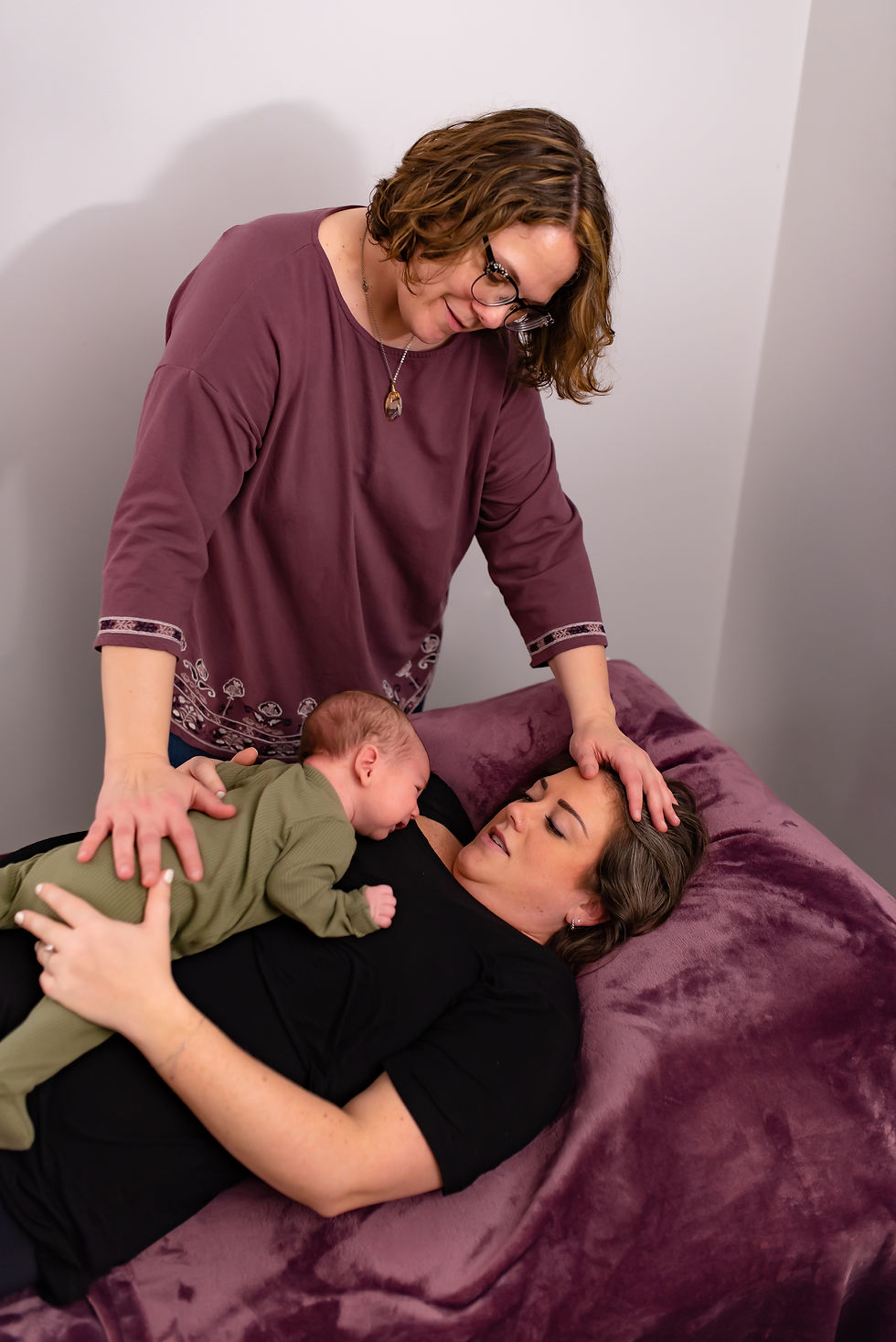Healing After Birth: How Craniosacral Therapy Supports Postpartum Parents and Their Babies
- Austin Rees

- Jul 15
- 4 min read
Updated: Aug 2

The body is a brilliant self-regulating system. Through rest and sleep it regenerates; helping to self correct the wear and tear caused by stress. However, each additional stress or trauma on the body can limit its ability to function optimally. Craniosacral therapy practitioners are trained to feel for blocks or restrictions in the body. We search for the “traffic jams,” and assist with rerouting the “traffic” so that the body can function more efficiently. Craniosacral therapy incorporates a light therapeutic touch and gentle traction to help release bone and tissue restrictions in the body. Craniosacral therapy works on the connective tissue surrounding the brain and spinal cord to bring the Nervous System into balance. This form of bodywork is gentle and supportive, yet creates deep change.
Healing After Birth: How Craniosacral Therapy Supports Postpartum Parents
Bringing a baby into the world is a profound experience, but for many parents, birth doesn’t go as planned. Whether it involved long labor, unplanned interventions, emergency surgery, or emotional overwhelm. Birth trauma can linger in the body and the nervous system long after the birth. These experiences often leave imprints on the nervous system, manifesting as anxiety, overwhelm, difficulty bonding, chronic tension, or even persistent pain.
That’s where craniosacral therapy (CST) can play a gentle yet transformative role in the healing journey for both parent and baby.
What is Birth Trauma?
Birth trauma can be physical, emotional, or both. If a parent feeds they have been traumatized, it was traumatic. We listen to their experience from their view and believe them. It may include:
Emergency C-sections or unplanned interventions
Feelings of helplessness, violation, or lack of control during labor
Physical injuries to the pelvic floor, abdomen, or spine
Unexpected NICU stays or early separation from baby
Grief, fear, or disappointment around how the birth unfolded
How Craniosacral Therapy Helps Postpartum Parents Heal
CST is a gentle, hands-on therapy that works with the nervous system, fascia, and craniosacral rhythm to help the body release tension, integrate experiences, and restore a sense of safety and balance. For postpartum parents, this can be deeply grounding and affirming.

Here’s how CST supports healing after a traumatic birth:
1. A Safe Place to Be Heard
In our offices and on our tables, parents are safe to be heard, held, and seen. There is space to process your birth experience, whether or not it’s been shared before. You’re met with compassion, not judgment.
2. Regulates the Nervous System
CST helps shift the body out of "fight-or-flight" and into "rest-and-digest." This supports nervous system recovery, reduces anxiety, and creates space for emotional ease.
3. Releases Stored Tension
Birth can create tension patterns in the pelvis, diaphragm, shoulders, and neck. CST offers gentle unwinding of these restrictions, helping your body breathe, move, and rest more freely.
4. Processes Emotional Imprints
Emotional trauma often gets held in the tissues of the body. During CST, feelings like fear, sadness, or grief may gently rise to the surface to be processed and released, without needing to retell or relive the entire experience.
5. Supports Breastfeeding and Bonding
When parents feel more connected to their bodies and more emotionally regulated, it naturally enhances bonding with their baby. CST also supports posture and physical comfort during feeding and holding. While on the table a parent can nurse in a laid back position, bottle feed with baby propped up, or practice sidelying comfortably.
CST helps babies heal from birth
Babies experience birth, too, and sometimes it’s tough. Whether from prolonged labor, fast delivery, surgical birth, or assisted delivery (forceps/vacuum), CST helps babies:

Release tension from cranial molding or body compression
Improve nursing/latching and oral function
Calm digestive discomforts like reflux or colic
Settle more easily and sleep more peacefully
Feel safe and connected in their new bodies
When parents and babies receive care together, there’s a beautiful co-regulation that happens. As the parent settles, so does the baby, and often, vice versa.
A Gentle Invitation to Heal

Postpartum healing is layered and non-linear. You may feel physically fine but emotionally raw, or vice versa. Whether it’s weeks or months after birth, if you’re carrying tension, grief, or unspoken feelings, CST offers a non-invasive, compassionate space to support your whole self.
You are not alone. Your story matters. You are safe and will be heard here.
Whether you’re navigating healing after a challenging birth or simply want to feel more grounded and connected in this new chapter of life, craniosacral therapy offers a gentle hand to hold along the way, for both you and your baby. We welcome you on our table.
Kate and I have three options for parents to receive CST. We offer adult sessions, (check out Kate's summer special), Parent/Child sessions, and 30 minute adult add-on to an infant CST follow up session. We want to ensure parents have several choices to get their own bodywork.
When supporting parents who are healing physically and emotionally from birth, we also share local recommended mental health and postpartum doula resources. Birth comes with complex emotions and parents are worthy of an unbiased safe and productive opportunity to process this new experience. Reach out to us anytime for our personal recommendations for local perinatal professionals for someone you care about or yourself.





Comments